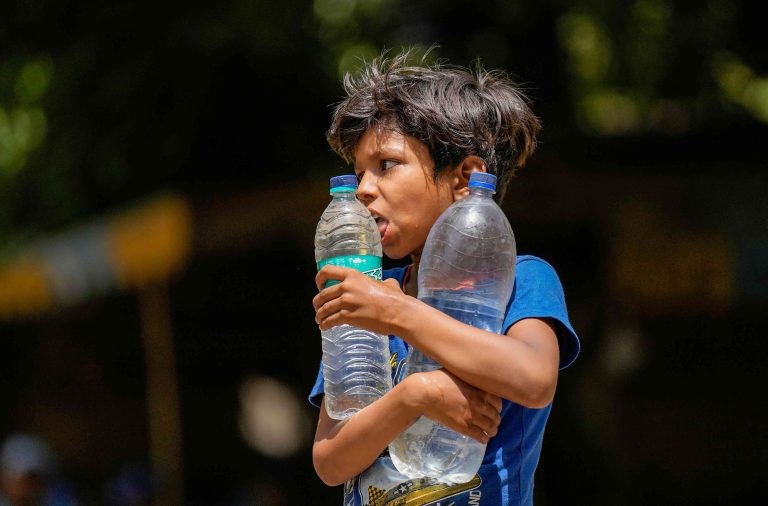
Climate change is fueling deadly heat waves in India. Global warming and these heat waves are having a significant negative impact on education in India. As UNICEF has put it so succinctly, “The heat is on in India!” The impact is disproportionately felt by students from poorer backgrounds, as heat-induced livelihood crises and financial vulnerabilities force them to drop out of school. This exacerbates educational inequalities.


Bihar, India. Recently, the Philippines closed their school system as the temperature hit 99°, with a heat index of 113°. By contrast, the temperature outside our school in Bihar, India this week hit 104° with a heat index of 116°.
On a 104°F day, a cement school building with a metal roof experiences interior temperatures in the range of 130°F or higher due to the heat absorption and transfer properties of the roof and building materials.
One of our board members, Dr. Kazuko Tatsumura, actually fainted from the heat at our school’s opening ceremony. Although we have not closed, attendance is unsurprisingly down 90%.
The increasing frequency and intensity of heat waves in India are disrupting education and learning outcomes for students. Heat waves lead to school closures, changes in school timings, and a shift to online classes, which is not an option for our students due to the digital divide.



Extreme heat makes learning difficult, as it impairs cognitive development, reduces concentration, and lowers academic achievement. Studies show that for every 1°F (0.56°C) rise in temperature, there is a 1% learning loss, reducing a child’s academic achievement by 4-7% annually.
Schools in India often lack adequate infrastructure like ventilation, cooling, and water supply to deal with the increasingly hotter summers, creating an unfavorable learning environment.

Addressing this issue requires long-term policy measures, such as developing climate-resilient school infrastructure guidelines, incorporating climate action priorities in education planning and budgeting, and mainstreaming climate education in the curriculum.

Children’s test scores in the developing world lag far behind developed countries. Heat will make that worse, widening between tropical developing nations and developed countries. But sending children to overheated schools could make them sick.

Bangladesh continues to waver between opening and closing schools for about 33 million students amid pressure to prepare pupils for exams — even as temperatures climb to dangerous levels, according to Voice of America (VOA).

Many of the country’s schools “don’t have fans, the ventilation is not good, and they might have tin roofing, which does not provide good insulation,” said Shumon Sengupta, Bangladesh country director for nonprofit Save the Children.
ADVERTISEMENT

Josh Goodman, an economist at Boston University, states, “When students in these places experience a year with more heat, they appear to have learned less. That is worrying, he adds, because as the world warms hot countries moving to an extremely hot climate will suffer more than temperate countries. “Climate change will widen the learning gaps between hot and cool countries,” Goodman said.
In Bangladesh, “last year, schools were closed for six to seven days,” said Save the Children’s Sengupta. “But this year, they are saying it might be closed for three to four weeks.”
May is generally the warmest month of the year in South Asia and most dangerous for children. Why? When children are not in school, they are more vulnerable to child labor and child marriage.

What can be done?
Several solutions can help keep our school cooler. We have already implemented the following improvements to help you mitigate the problem:

- Ceiling Fans: Installing ceiling fans can help circulate air and create a breeze, making the interior feel cooler.
- Planting Trees: Planting trees around the school can provide shade and help lower ambient temperatures.
Next, we must raise additional funds to build out:
- Insulation: Adding insulation under the metal roof can reduce heat transfer into the building.
- Reflective Roof Coating: Applying a reflective coating on the metal roof can reflect sunlight and reduce heat absorption.
- Green Roof: Implementing a green roof with plants can provide natural insulation and cooling through evapotranspiration.
- Solar Panels: Installing solar panels above the metal roof can create a shaded area and reduce direct sunlight exposure.
- Shade Structures: Erecting shade structures or awnings over windows and entrances can block direct sunlight.
- Cool Roofing Materials: Consider using cool roofing materials such as traditional thatch that reflect more sunlight and absorb less heat.
Combining several of these solutions can significantly improve the comfort level within the school building.

The Saraswati Free School, a primary school, is a project of the J. Luce Foundation overseen by the J. Luce Foundation India. It is located adjacent to the Saraswati Tree, the bodhi tree Lord Buddha sat under after

from nearby Nepal to Bihar, India and obtaining enlightenment. After sitting under this tree, he journeyed into Bodhgaya and sat under the second tree which is where the Mahabodhi Shrine is located today.
